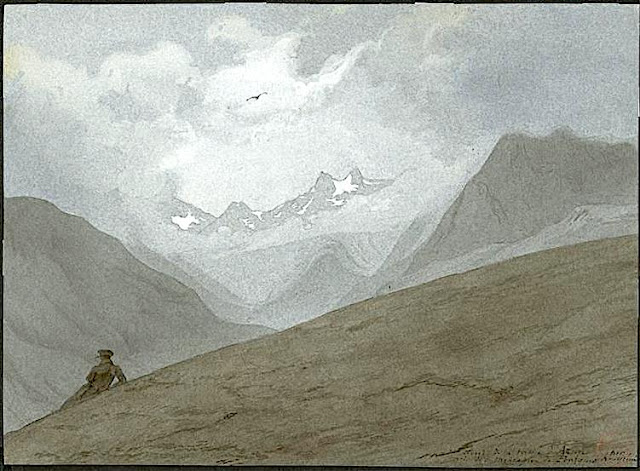PAUL HUET (1803–1869)
Les Monts du Vaucluse (807m - 1910m)
France (Vaucluse)
In "Fontaine de Vaucluse ", aquarelle sur papier marouflé, The Brooklyn Museum
Le massif
Les monts de Vaucluse sont un massif montagneux français des Préalpes du Sud, dans les départements de Vaucluse et des Alpes-de-Haute-Provence, en Provence. La partie septentrionale est formée par les chaînons du mont Ventoux — point culminant du massif avec 1 910 mètres d'altitude — et de la montagne de Lure (1 825 m), séparés par le plateau d'Albion (1 393 m). La partie orientale est un plateau d'altitude moyenne qui oscille entre 800 et 1 000 mètres et culmine au signal de Saint-Pierre à 1 256 mètres d'altitude. La partie occidentale est formée de chaînons, depuis la région de Sault jusque vers la plaine. L'altitude varie entre 300 m et 1 000 m. Les Dentelles de Montmirail (722 m), à l'ouest du mont Ventoux, tirent leur nom de la forme obtenue par l'érosion de la roche. Le massif est formé de calcaires du Mésozoïque, souvent perméables. L'eau s'enfonce dans la roche, créant des réseaux souterrains (système karstique), ressortant aux points bas comme la fontaine de Vaucluse. Il y a de nombreux avens : celui du Souffleur à Saint-Christol (921 mètres), celui du Caladaïre, près de Montsalier (667 mètres), l'aven Autran (670 mètres) à Saint-Christol, ainsi que l'aven de Jean Nouveau (578 mètres) à Sault, sont parmi les plus profonds ; figurent également d'autres cavités comme l'aven du Calavon, la source des Brieux ou l'aven des Mûres.
Sommets principaux
Mont Ventoux, 1 910 m, point culminant du massif
Signal de Lure, 1 825 m
Sommet de l'Homme, 1 637 m
Contras, 1 633 m
Le Tréboux, 1 535 m
Montagne d'Albion, 1 413 m
Signal de Saint-Pierre, 1 256 m
Colline de Berre, 1 187 m
Le Buisseron, 1 120 m
La Grand-Montagne, 1 051 m
Le Cluyer, 1 041 m
Le Pointu, 872
Paul Huet, n est un peintre et graveur français. Il est l'élève de Pierre-Narcisse Guérin et d'Antoine-Jean Gros, mais est en rupture avec eux. Paul Huet reste connu pour ses paysages romantiques, œuvres tourmentées à la touche large, aux couleurs contrastées et aux sujets menaçants. Jouant d'opposition marquée d'ombres et de lumières devant une nature sauvage, Paul Huet a été un des peintres les plus proches de Lamartine, par l'expression romantique du paysage. Surnommé « le Delacroix du Paysage », la modernité de sa peinture par sa facture, ses couleurs, sa quasi absence de sujet, son travail en plein air font de l'artiste un précurseur de l'impressionnisme. L'œuvre de Paul Huet évolue d'un paysage rêvé, idéalisé, romantique qui rappelle par ses cieux tourmentés la peinture de Georges Michel à une peinture naturaliste qui préfigure l'impressionnisme par des aquarelles et des carnets de voyage, précis voire ethnographiques sur les régions françaises. Son œuvre est donc marqué par le lyrisme « des orages et la fureur des flots » cher aux écrivains Victor Hugo, Jules Michelet ou Alexandre Dumas. Ses aquarelles sont des études des variations et des effets atmosphériques, suggérant formes et coloris d'autant qu'il est un des premiers artistes français à pratiquer l'aquarelle avec une liberté comparable à celle des peintres anglais. Profondément marqué par Constable à ses débuts, l'influence de Turner est notable autour de 1828 où il dissocie les formes et les lumières, dont l'aquarelle "Matinée d'hiver près du Pont-Neuf" est un exemple frappant. Cette pratique tend à disparaître après 1835.
Il utilise des tons purs depuis 1828 dans une époque qui valorise les tons rompus. À partir de 1845, sa touche se fait large et juxtaposée évoluant à partir de 1862 pour une touche plus ronde qui sera vue et assimilée par Claude Monet, Alfred Sisley ou Camille Pissarro alors que les peintres impressionnistes ont pu comparer Turner et Huet au Salon et à l'Exposition universelle de 1855. À partir de 1863, son œuvre devient pré-impressionniste par des effets de dégradation de la lumière aussi bien dans les aquarelles de paysages d'Apt dans le Vaucluse que dans son dernier chef-d'œuvre, une peinture à l'huile : La Laïta à marée haute (1865-1868).
Cependant, l'œuvre de Paul Huet reste peu ou mal connue car peu étudiée dans sa totalité, la dernière grande rétrospective de Paul Huet datant de 1938.
________________________________________
2025 - Gravir les montagnes en peinture
Un blog de Francis Rousseau
%20%20-_Fontaine_de_VaucluseBrooklyn_Museum-%20watercolor%20on%20cream%20wove%20paper_.jpg)

%20Extraite%20du%20portfolio%20%22Naples%22%20%20e%CC%81dition%20limite%CC%81e%20a%CC%80%20300%20ex%20Editeur%20:%20Compagnie%20de%20Saint-Gobain,%20Paris,%201959%20%2037,5%20x%2028%20cm%20%20%20.png)



%20,%20oil%20on%20cardoarod,%20LEs%20dents%20du%20Midi,%201949.%20PC%20.png)
%20ALPILLES,%201977%20Dessin%20a%CC%80%20l'encre%20de%20Chine%20sur%20papier-%20100x%20149,80cm%20-%20Artcuiral%20CP%20.png)








